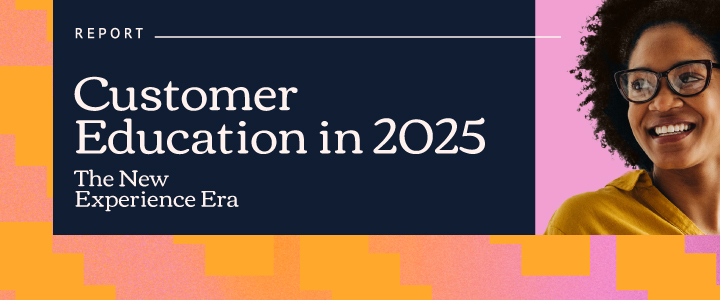
6 min reading time
Activate Faster: The Role of Education in Seamless Customer Onboarding & Enablement
What you’ll learn:
- Customers struggle to see value quickly, slowing adoption and increasing churn.
- Structured onboarding delivered through a customer academy platform wins faster and reduces one-on-one support.
- Enablement builds confidence and momentum beyond initial success.
- Role-based customer education, guides, and microlearning reinforce engagement.
- Smooth activation drives measurable impact: faster time to value, higher adoption, and scalable growth.
Even the best products can struggle to deliver value if customers don’t quickly understand how to use them, and what’s in it for them. This disconnect not only slows product adoption, but also increases churn risk. And what’s worse: the usual fix, costly one-on-one “hand-holding”, isn’t scalable.
The solution? A well-designed customer onboarding program that helps users master your product faster and gain confidence from day one. And we have the secret sauce recipe: Customer education.
This is the focus at Activate, the third stage in LearnUpon’s customer lifecycle framework, which is designed to leverage education across every phase of the customer journey.
The goal? A smooth setup and faster time to value, achieved through two things: effective onboarding that shows customers how to use your product, and enablement that builds early momentum with best-practice resources.
The Common Challenges in Customer Onboarding and Enablement
Collecting a customer signature on the dotted line might feel like the ultimate win—but it’s only the beginning. Customer onboarding and enablement processes are fundamental for setting new customers up for success and laying the groundwork for long-term customer value.
Yet, activation often runs into major roadblocks. These challenges not only frustrate customers, but also slow adoption, delay time to value, and increase churn risk.
Before diving into solutions, let’s look more closely at the most common Activate stage challenges that stand in the way of smooth customer activation:
- Over-reliance on one-on-one support: Onboarding that leans heavily on “hand-holding” is costly, not scalable, and conditions customers to expect close guidance instead of empowering themselves. The pressure is real—36% of organizations cite scaling support as a top driver for expanding customer education, while 26% specifically point to reducing support costs. Without scalable onboarding and enablement, these costs tend to grow.
- Information overload: New customers are welcomed by substantial technical information upfront. Instead of feeling confident, they become overwhelmed and disengage before hitting their first wins.
- Inconsistent onboarding experiences: Without a standardized process, some customers receive exceptional support, while others are left behind. This leads to uneven adoption, frustration and erosion of trust early in the relationship.
How Customer Education Accelerates Time to Value in Onboarding
The good news? There’s a solution that addresses not one or two of the mentioned challenges, but all of them: customer education.
Customer Education as the Foundation of Onboarding
An automated, learning-focused onboarding not only eliminates the need for one-on-one support, but also allows you to be strategic about the information you share—delivering content that is structured, and purposeful. On top of that, it gives you control over the onboarding experience, ensuring it is consistent, engaging, and most importantly, empowering for every customer.
And it pays off: 88% of organizations said onboarding has had a direct impact on their business performance, with a quarter calling it significant. Structured learning turns onboarding from an ad-hoc experience into a consistent growth lever.
Examples of Structured Onboarding
Unsure about what structured customer onboarding looks like in practice? Let’s take a look:
- Step-by-step tutorials and product tours: Guide users through the product so they can reach their first success quickly.
- Interactive guides: Provide step-by-step support that simplifies complex workflows.
- In-app customer education: Simplify the experience by delivering bite-sized actions in context through a customer academy.
- Role-based learning paths: Tailor content to be delivered through a customer academy, so different user types find it relevant and impactful.
- Automated onboarding emails & drip campaigns: Deliver lessons and tips at the right time, outside the product.
Structured onboarding is always sequenced, role-relevant, and goal-oriented, often combining multiple formats to guide users to their first success moment quickly.
Real-life example: LearnUpon University
One example of successful customer education strategies applied to the Activate stage comes from inside the house: LearnUpon University. Using our own academy platform, we built it to help our customers deliver smarter, scalable onboarding that gets users to value faster.
Our tailored learning and role-based courses guide each type of user through the courses that are most relevant to them.
And it paid off big.
After implementation, we saw a reduction in time-to-launch for new customers by 12.5%, faster adoption, and more confident users. All while we reduce support costs and scale onboarding without dramatically increasing headcount.
Onboarding, the first half of the Activate stage, gets customers started; but enablement ensures they keep moving forward. By taking the right learning approach, you help customers move from first wins to sustained success—building long-term confidence.
Keep the Momentum Going: Customer Enablement Strategies
Also part of the Activate stage, enablement ensures that customers are supported with ongoing guidance to succeed beyond the first milestones. It helps them build confidence, adopt advanced features and, consequently, realize value faster.
Done right, enablement prevents stagnation that can follow after onboarding. It builds trust, and strengthens customer relationships early—still within the first weeks or months.
Customer Education Strategies for Enablement
Enablement strategies supported by learning include:
- Best-practice guides & templates: Show customers how to apply the product effectively in real-world scenarios.
- Role-specific learning paths: Deliver content tailored to different user roles for relevance and impact within a customer academy platform
- Self-service resources: Knowledge bases, FAQs, and videos that support just-in-time learning.
- Microlearning & bite-sized content: Short modules that reinforce key concepts and build confidence gradually within a customer academy platform.
You may notice some of these formats also appear in onboarding—but the key difference is timing and purpose. Onboarding focuses on getting started, while enablement focuses on building momentum and confidence beyond the first wins.
The results tend to speak for themselves: enablement increases adoption of advanced features (beyond basic onboarding), improves satisfaction, confidence and trust, while reducing reliance on support teams for advanced questions.
The Business Impact of Smooth Activation
It all makes sense, but how do we tie activation back to business goals? The magic lies in measuring the right outcomes. Smooth onboarding and enablement don’t just make customers happier. They drive real business impact.
Key metrics to track include:
- Time to Value (TTV): How quickly it takes for a customer to perceive the benefits of a product after purchase.
- Adoption Rates: Increased usage of both core and advanced features signals stronger product stickiness.
- Customer Satisfaction (CSAT/NPS): Confident customers are more likely to rate their experience highly and advocate for your brand.
- Retention & Renewal Rates: Smooth activation lowers churn risk and sets the foundation for long-term loyalty.
- Reduction in One-on-One Support: Automated and scalable learning reduces reliance on high-cost “hand-holding.”
And the data backs it up. 89% of organizations report seeing a direct ROI from customer education, and 90% say it has boosted customer satisfaction scores—showing that smooth activation isn’t just a nice-to-have.
The takeaway is simple: smooth activation isn’t just about making onboarding easier; it’s about driving measurable business impact. Customers achieve value faster, your teams scale without ballooning costs, and long-term growth becomes a natural outcome.
Best Practices for Successful Customer Onboarding and Enablement in the Activate Stage
How do you go from the drawing board to real-world actions? By applying best practices for onboarding and enablement that turn learning into measurable results! Here’s how to get started:
Invest in a Customer Academy Platform
A customer academy platform serves as a centralized hub for structured education. It consolidates tutorials, courses, and on-demand content all in one place, avoiding scattering resources across emails, docs and support tickets.
Map Content to Customer Goals
Let your customer outcomes guide your content mapping. What do they care about the most? Teach them how to get it from your product. Focus on skills, tasks and workflows that help users reach value faster.
Personalize Learning Paths
Personalization is the key for increased engagement. Tailor content not only to different roles, but also experience levels and use cases. Once again, let your user goals guide you—provide what’s most relevant to them. No unnecessary steps.
Use In-App Guidance to Reduce Friction
Meet your customers where they are. Provide step-by-step product tours, interactive checklists, and tooltips inside the app. Guidance at the right time avoids friction: users don’t have to leave the product to learn. The result? Reduced confusion, sped up adoption, and increased confidence.
Collect Feedback to Optimize your Course Content
Who better to let you know what’s working than those experiencing the learning you’re building? Use surveys, NPS/CSAT, or embedded learning analytics to understand what works. From there, iterate and update materials—all based on real usage. Ensure the content remains relevant and aligned with evolving customer needs.
Unlock Product Value Faster Through Customer Education
With the right strategy, tech stack, and tools in place, learning ensures smooth activation and lays the groundwork for long-term engagement. More than that, it creates the foundation for Engage—the next stage of the customer journey, where relationships deepen through value-driven experiences.
The takeaway is clear: When activation is powered by education, customers not only adopt your product quickly; they gain the confidence to explore its full potential.
If you want to see how customer education continues to drive value, download our whitepaper, Customer Education in 2025, for the latest trends, strategies, and insights shaping education-led growth.



